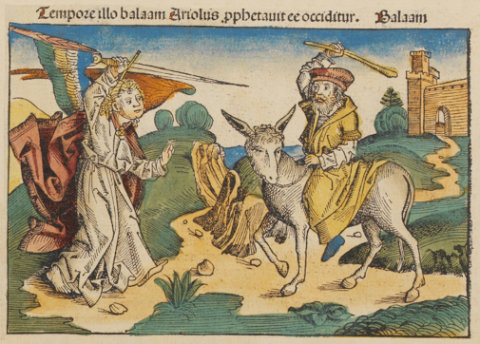Fountain of Balaam's Ass
"Balaam's ass is quite unconnected with the geography of this episode but perhaps not with its theme. The ass helped his master discern whom he should curse, whom bless, taught him to choose the true chosen people (Numbers xxii). Whether or not that was Mark Twain's motive for pressing Balaam's ass into literary service, the beast serves well in the anti-pilgrim rhetoric: "Not content with doubling the legitimate stages, they switched off the main road and went away out of the way to visit an absurd fountain called Figia, because Baalam's ass had drank there once" (p. 453). And in the next chapter, Mark Twain presents an excerpt from what he claims is "the terse language of my note-book": "nooned an hour at the celebrated Baalam's Ass Fountain of Figia . . . guide-books do not say Baalam's ass ever drank there-somebody been imposing on the pilgrims, may be" (IA, Ch. 44, p. 454). Even as Bible-scholars, the pilgrims prove frauds."
The town was built around the Ain al-Fijah springs (Greek: πηγη, romanized: Pigi, means "Spring"), the source of the Barada River which supplies Damascus with freshwater. In the 1st century CE, the Romans constructed a temple at Ain al-Fijah. In 1907, the Ottoman authorities installed the first clean water pipe was installed at the springs. In 1924 Syrian businessmen Lutfi al-Haffar and Abd al-Wahab al-Qanawati founded the Ain al-Fijah Company, which would use water from spring for irrigation purposes. Throughout the early 20th-century, the company was one of the most profitable and innovative in Damascus.
The Fountain of Fijeh is one of the largest and most remarkable in Syria. It bursts forth from a narrow cave, under an old temple, at the base of a shelving cliff. The mouth of the cave is small, and partly filled up by massive blocks of stone; through this the pent-up water leaps and foams with a roar like that of a stormy sea. It forms at once a rapid torrent, 30 ft. wide, and 3 or 4 deep, which rushes over a rocky bed for 70 or 80 yds., and then joins the Barada. Though not the highest. Ain Fîjeh is the principal source of the river, its volume being 2 or 3 times that of the other stream. Just over the fountain is a small platform of heavy masonry, and behind it the ruins of a temple some 30 ft. square, with massive walls, but without any kind of ornament. To the rt. of the fountain is a singular building, 37 ft. by 27, open to the S.; the walls are 6 ft. thick, built of huge stones, and it was formerly covered by a vaulted roof. The whole structure is manifestly of remote antiquity.
